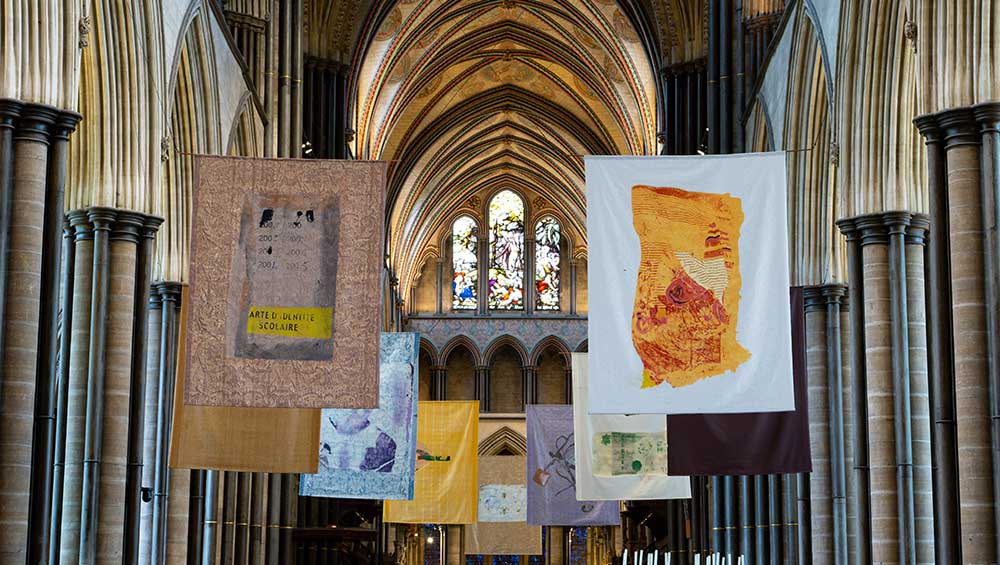
Shezad Dawood: Leviathan, installation view, Salisbury Cathedral, 28 November 2023 – 3 February 2024. Photo: Finnbarr Webster.
Salisbury Cathedral
28 November 2023 – 4 February 2024
by JOE LLOYD
When Thomas Hobbes titled his great treatise on government Leviathan (1651), he was favouring one interpretation of that word over another. The Leviathan was a biblical sea beast of humongous scale and might: “Upon Earth there is not his like, who is made without fear” (Job 41:33). Theologians were divided over whether Leviathan represented the loftiness of God’s power or a harbinger of the apocalypse, a “crooked serpent” (Isaiah) that resurfaces as a 10-headed dragon in the Book of Revelation. Hobbes tends towards the first reading. His Leviathan is a great “common-wealth, or state”, a metaphor for power.
Since Hobbes, Leviathan has lost some of its interpretative ambiguity. Herman Melville used the term interchangeably with whale. It has become a catch-all term for “sea monster”. Leviathans of one sort or another appear in various video games and horror films. It has come to Shezad Dawood to revive its rich ambiguity. At the 2017 Venice Biennale he revealed the first films from his Leviathan Cycle. This set of works has since expanded to comprise a 10-part film cycle as well as paintings, sculptures, neon works, virtual reality pieces, public programmes and a research archive. Dawood has opened a climate research non-profit company funded from the sale of the works.
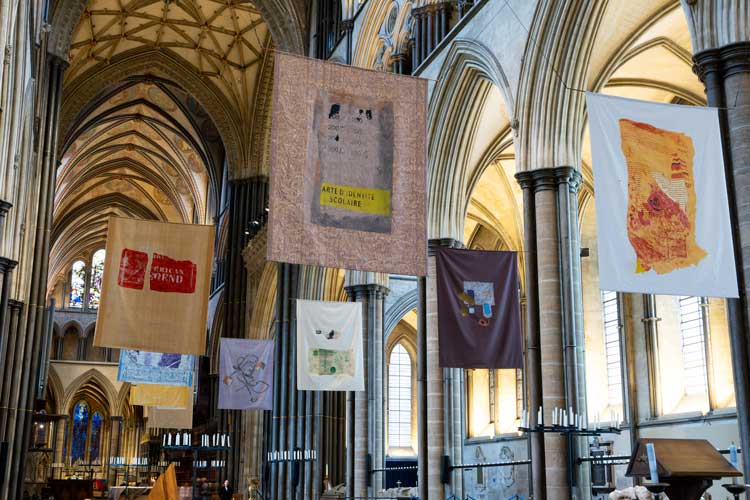
Shezad Dawood: Leviathan, installation view, Salisbury Cathedral, 28 November 2023 – 3 February 2024. Photo: Finnbarr Webster.
Created through collaboration with a vertiginous array of experts across various cultures, Dawood’s works loosely imagine a near-future after a “cataclysmic solar event” has ravaged the Earth. “While new empires formed and contested their boundaries,” says the narrator of episode seven of the film cycle, “new formations and knowledge sharing were being born”. They aim to connect three contemporary concerns: climate change, migration and mental health. Works from the cycle have been shown in 17 international institutions and five international biennales. But now they have arrived at a particularly striking venue: Salisbury Cathedral, one of the masterpieces of early English gothic. A selection of Dawoood’s works, including a textile work, two sculptures, two films and 12 paintings on textile have been installed across the cathedral’s Chilmark stone surfaces.
Leviathan Cycle episodes 7 (2022) and eight (2023) are each about 20 minutes long, and demand contemplation. While earlier instalments focused on the disaster, these see artists and activists imagining their lives afterwards. Episode seven was filmed along Senegal’s mangroves, while episode eight stars Brazil’s Atlantic rainforest. They intercut interviews with footage of wildlife and landscape. Episode eight was created during Covid, and saw Dawood relinquish control of filming to the participants. It is looser, often dream-like, with animated passages. Both films effectively present the sense of a world adrift. While episode eight is well-positioned in the spacious Lady Chapel, episode seven is stifled somewhat in the North Transept: a hazard of such an historically complex space.
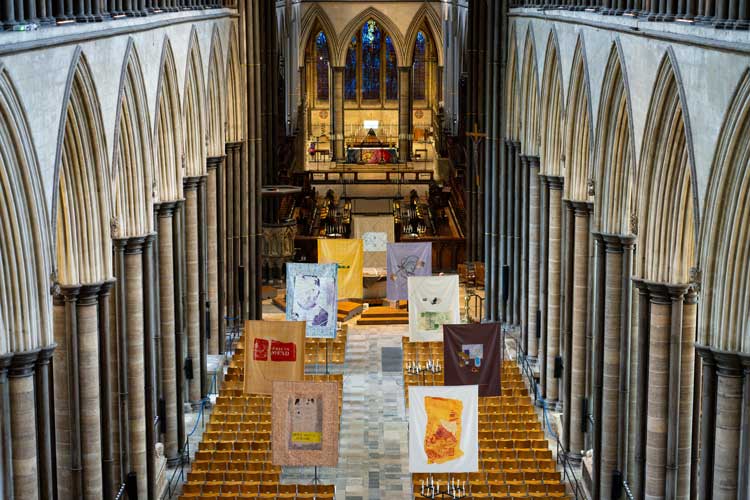
Shezad Dawood: Leviathan, installation view, Salisbury Cathedral, 28 November 2023 – 3 February 2024. Photo: Finnbarr Webster.
By contrast, the Labanof Cycle (2017) of textile painting simultaneously occupies the most prominent positions in the cathedral and melds the most with its usual decorations, such as the regimental flags that hang from the north wall. Nine of them float above the nave in a pyramidal formation, while three more hang off-set in the South Transept, attached to ropes on the cathedral’s triforium. Squatly rectangular – curator Beth Hughes describes them as “postage stamps in the air” – they are both delicate and firm. They are printed on fabrics by the Venetian manufacturer Fortuny, some designed by Mariano Fortuny himself in the 1920s.
Fortuny was a Spanish artist and designer who migrated around Europe before ending up in Venice, living in the 15th-century palazzo that now bears his name. Dawood’s works concern a more precarious type of migrant. Each depicts an object lost at sea during attempted Mediterranean crossings. These items are held in trust by Labanof, the anthropological and odontological lab of the University of Milan, and are used to help people track missing relatives. Dawood has gracefully rendered these objects on to textile with polymer paint and screenprint.

Shezad Dawood: Leviathan, installation view, Salisbury Cathedral, 28 November 2023 – 3 February 2024. Photo: Finnbarr Webster.
There is a passport, a student ID and a vaccination card; and also a cigarette packet, an I Love Mali bracelet and a USB memory stick. One features a decorative cloth, perhaps a memento of home. Two feature small plastic bags of the sort used for powdered drugs, which contain tiny snatches of homeland soil. These objects become memorials for the disappeared, spurs to prayer. We may know little of the lives they pertain to, but Dawood grants them a presence. Surrounded by the cathedral’s numerous funerary monuments, they achieve a remarkable solemnity.
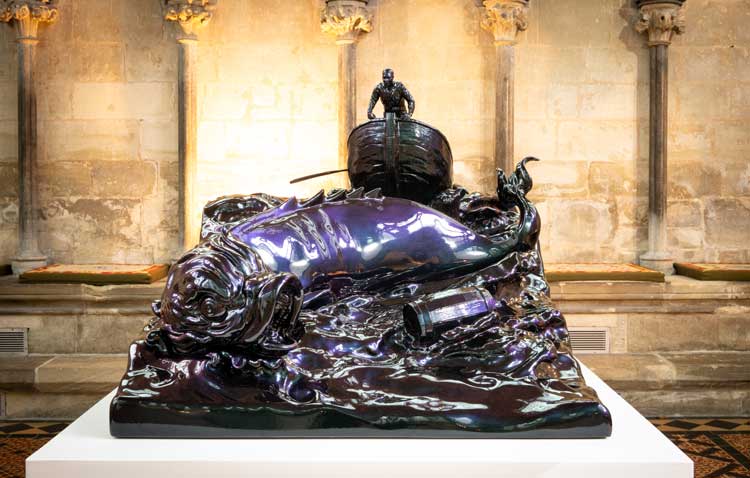
Shezad Dawood, Where do we go now? Installation view, Salisbury Cathedral, 28 November 2023 – 3 February 2024. Photo: Finnbarr Webster.
There are two actual Leviathans in the show. One of them is part of Where Do We Go Now? (2017), a sculpture based on an engraving from Jonathan Swift’s satirical 1704 pamphlet A Tale of a Tub, which parodied Hobbes. Here the sea beast representing the state rocks the boat of community, whose sailors throw out a barrel representing their labour to appease it. Dawood has incarnated this image as a 3D render. It is covered in an experimental polychromatic paint that shifts between black, green and purple with light and perspective, echoing the appearance of the sea itself. The sculpture sits within Salisbury’s Chapter House, next to the cathedral’s original copy of the Magna Carta. That document has been held up as the first to argue that the government is subservient to the law. But Dawood’s sculpture questions the idea that power can be legally constrained. It is a rampant beast, and all we can do is distract it.
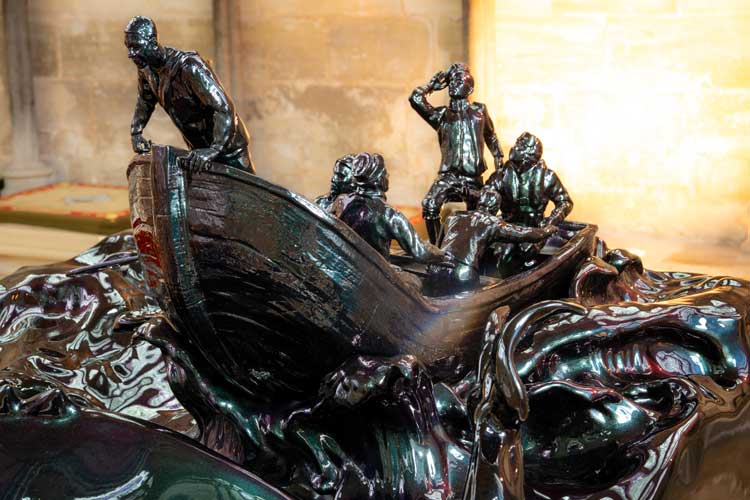
Shezad Dawood, Where do we go now? Installation view, Salisbury Cathedral, 28 November 2023 – 3 February 2024. Photo: Finnbarr Webster.
The second is the title piece of the entire project, also from 2017. It is a small resin sculpture of a dead sperm whale with a man – modelled on Gregory Peck’s Ahab in the 1956 screen adaptation of Moby-Dick – tied to its back. Dawood has finished it in cotton steel, which makes it look a little like a rusty artefact pulled out of the sea, albeit neater than anything so encrusted. Placed in the cathedral’s surviving chantry chapel, it sits in a vitrine like a zoological sample in a natural history museum, atop a communion table, a piece of furniture usually used to hold open Bibles. And in a way it serves as Dawood’s own scripture: a vision of man and nature hurtling towards their joint destruction.